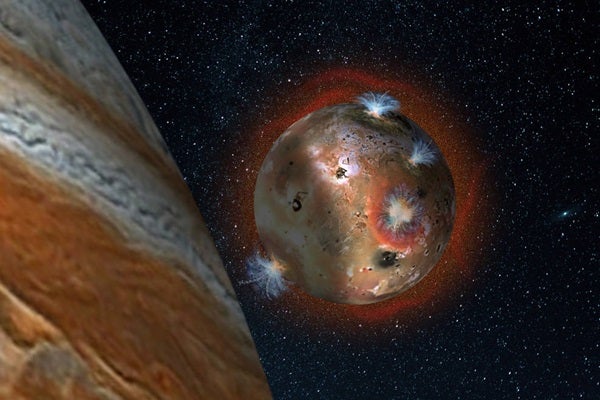As one of the four Galilean moons, Io has played an important role in Astronomy since its discovery in 1610. It is the fourth largest moon in the solar system while also being the most geologically active, but a new study may add a new and interesting aspect to this moon.
Using the the Gemini North telescope and its instrument the Texas Echelon Cross Echelle Spectrograph (TEXES), a group of scientists documented unique atmospheric changes on Io. They found that Io’s thin atmosphere, which is mostly sulfur dioxide gas vented from volcanoes, collapses and freezes onto the surface when shaded by Jupiter. The results are published in the Journal of Geophysical Research-Planets.
“This research is the first time scientists have observed this phenomenon directly, improving our understanding of this geologically active moon,” says Constantine Tsang, lead author and senior research scientist at Southwest Research Institute’s (SwRI) Space Science and Engineering Division, in a press release.
Once temperatures on the moon drop below -235 degrees Fahrenheit during an eclipse, Io’s atmosphere appears to “deflate.” These eclipses occur fairly frequently; two hours of every Io “year” (it orbits Jupiter once every 1.7 Earth days) it is eclipsed. Most of the sulfur dioxide gas in the atmosphere settles to the moon’s surface as frost during a full eclipse. Once the moon warms from sunlight, the atmosphere redevelops.
“This confirms that Io’s atmosphere is in a constant state of collapse and repair, and shows that a large fraction of the atmosphere is supported by sublimation of sulfur dioxide ice,” says John Spencer, a SwRI scientist who also participated in the study. “Though Io’s hyperactive volcanoes are the ultimate source of the sulfur dioxide, sunlight controls the atmospheric pressure on a daily basis by controlling the temperature of the ice on the surface. We’ve long suspected this, but can finally watch it happen.”
This is the first time there have been direct observations of Io’s atmosphere in eclipse as it is very difficult to observe the atmosphere in the darkness of Jupiter’s shadow. Thanks to the specific capabilities of the TEXES instrument, this breakthrough was possible. The instrument measures the heat radiation emanating from the atmosphere not the sunlight, therefore Gemini was able to pick up the faint heat signatures of Io’s collapsing atmosphere.
The observations occurred over a two night stretch back in November of 2013 when Io was more than 675 million kilometers (420 million miles) from the Earth. Io was observed while moving in and out of Jupiter’s shadow for a period of about 40 minutes before and after each eclipse.
NASA’s Juno spacecraft, currently in orbit around Jupiter, may shed some light on how the phenomenon affects the planet.
“Io spews out gases that eventually fill the Jupiter system, ultimately seeding some of the auroral features seen at Jupiter’s poles,” says Tsang in a press release. “Understanding how these emissions from Io are controlled will help paint a better picture of the Jupiter system.”










